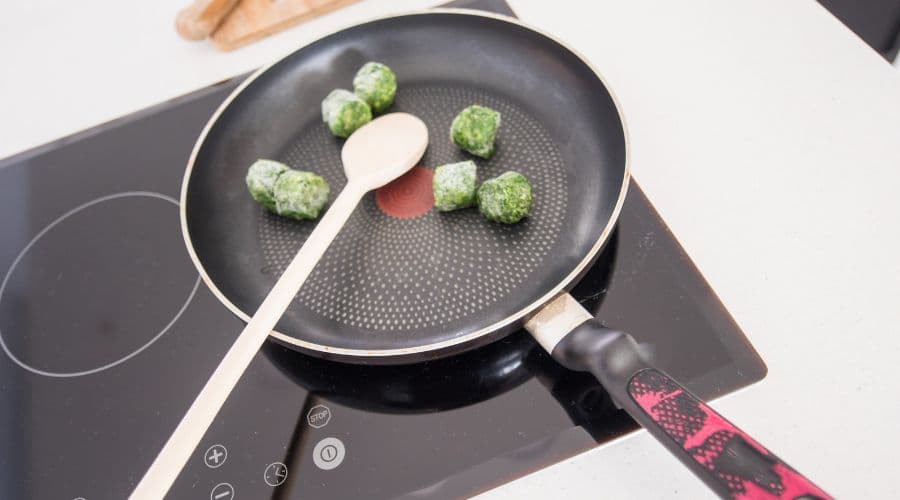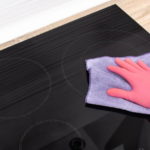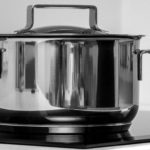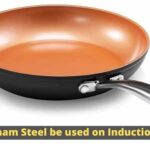What is Induction Cooktop And How Does It Work?

Induction cooktops have been growing in popularity in recent years because they offer a number of advantages over other types of stovetops. An induction cooktop uses electricity to create a magnetic field that cooks your food.
If you are thinking of buying an induction cooktop, you may be wondering how it works, and what the benefits are. Let’s take a closer look at how an induction cooktop works and whether or not it is the right choice for you.
What is an Induction Cooktop?
An induction stove is a type of cooking appliance that uses electromagnetic energy to heat food. The stove produces an electromagnetic field that causes currents to flow within metal objects, such as pots and pans.
These currents create resistance and generate heat, which is then transferred to the food.
An induction stove is fast and more efficient than traditional stoves because they heat the food directly, instead of heating the air around the food.
Additionally, because induction cooking only produces heat in the pot or pan, the surrounding area stays cooler to the touch, making it a safer cooking option.
What’s the science Behind Induction Cooktops?
If you have ever seen or used an induction cooktop, you know that it uses a magnetic field to generate heat directly in the cookware, rather than generating heat in the stovetop itself. But how does this magic happen?
An induction cooktop has an electromagnetic coil beneath the cooking surface. When an electrical current runs through the coil, it creates a magnetic field. This magnetic field is then used to generate heat directly in the cookware that is placed on top of the cooktop.
So, when you turn on an induction cooktop, the coil creates a magnetic field that induces or produces an electric current in the pot or pan. The electric current produces resistance to the flow of electrons, and in turn, creates heat. The cooktop then uses that heat to cook your food.
What pans work with an induction stove?
The most important factor to consider when purchasing cookware for use on an induction stove is compatibility. As we already mentioned that induction stoves work by using electromagnetism to generate heat and therefore require cookware that is made of a ferromagnetic material.
This means that the cookware must be made of either cast iron or stainless steel. Additionally, the pan or wok must have a flat bottom in order to make contact with the cooking surface.
There are a few exceptions to this rule, as some companies have developed induction-compatible cookware made of aluminum or copper. However, these materials are not as effective at conducting electricity and therefore do not work as well with induction stoves.
How to know if my pan is induction ready or not?
It’s actually very easy to test whether or not your cookware is compatible with an induction stove. All you need is a simple kitchen magnet.
If the magnet sticks to the bottom of the pan, then it will work with an induction stove. If the magnet does not stick, then the pan is not compatible and you will need to purchase new cookware.
Another method is to simply place a pan on an induction stovetop and see if it generates heat. If the pan is induction compatible, then it will start to heat up immediately.
How to use a non-induction pan on an induction stove?
If you have cookware that is not induction compatible, there are still a few ways that you can use non-induction cookware on an induction stove.
One method is to purchase an induction plate, which is a flat disk that can be placed underneath a pan to generate heat. These plates are relatively inexpensive and can be found at most home improvement stores.
Induction stove vs electric vs gas stove
There are many reasons to choose one stove over another. Each type of stove has its own advantages and disadvantages that must be considered before making a purchase.
Here is a look at the pros and cons of induction stoves, electric stoves, and gas stoves to help you make an informed decision about which type of stove is right for your needs.
Induction Stove Pros
- Induction stoves are very energy efficient. They use less energy than gas or electric stoves, so they can save you money on your utility bills.
- Induction stoves heat up quickly. They can reach cooking temperatures in a matter of seconds, so you can start cooking your food right away.
- Induction stoves are very safe to use. They do not produce any open flames, so there is no risk of fire. Additionally, the cooktop stays cool to the touch, so there is no risk of burns.
- Induction stoves are easy to clean. The smooth cooktop can be wiped clean with a damp cloth.
Induction Stove Cons
- Induction stoves can be more expensive than gas or electric stoves.
- Induction stoves require special cookware. Not all cookware is compatible with induction cooktops, so you may need to invest in new pots and pans if you switch to an induction stove.
- Induction stoves can be difficult to use. They require precise temperature control, so they may not be the best choice for inexperienced cooks.
Overall, induction cooktops are more efficient than electric and gas stovetops because they use less energy to generate heat. Additionally, they are faster than electric stovetops.
Additionally, induction cooktops are also safer than gas stovetops because they do not produce open flames. And, because the heat is generated directly in the cookware, the surrounding area stays cooler to the touch.
Electric Stove Pros:
- Electric stoves are very affordable. They are typically less expensive than induction stove.
- Electric stoves are easy to use. They do not require any special training or knowledge to operate.
- Electric stoves are safe to use. They do not produce any open flames, so there is no risk of fire.
- Electric stoves are easy to clean. The smooth cooktop can be wiped clean with a damp cloth.
Electric Stove Cons:
- Electric stoves can be slow to heat up. They may take several minutes to reach cooking temperatures, so you will need to plan ahead if you are using an electric stove.
- Electric stoves can be difficult to control. They can be hard to keep at a consistent temperature, so they may not be the best choice for inexperienced cooks.
Electric stovetops are a good option for those who are looking for an affordable and easy-to-use cooking option. However, they can be slow to heat up and difficult to control. Additionally, they can be expensive to operate.
Gas Stove Pros
- Gas stoves are very affordable. They are typically less expensive than induction and as well as an electric stoves.
- Gas stoves heat up quickly. They can reach cooking temperatures in a matter of seconds, so you can start cooking your food right away.
- Gas stoves are easy to use. They do not require any special training or knowledge to operate.
- Easily control Temperature. You can precisely control the temperature of a gas stove, making it easy to cook food perfectly every time.
Gas Stove Cons
- Gas stoves can be dangerous to use. They produce open flames, so there is a risk of fire. Additionally, the cooktop can get very hot, so there is a risk of burns.
- Gas stoves can be expensive to operate. They use a lot of gas, so they can add to your monthly utility bills.
Gas stovetops offer the advantage of being able to precisely control the temperature and is less expensive. However, gas stovetops can be dangerous to use and they are more expensive to operate than other types of stovetops.
Induction cooktops have a number of advantages over other types of stovetops.
They are more energy-efficient because they only generate heat in the cookware, rather than heating the air around the food. Additionally, they are faster than traditional stovetops because they can generate heat almost instantaneously.
Additionally, induction cooktops are safer to use because the cooking surface stays cool to the touch.
However, there are a few disadvantages to induction cooktops. They can be more expensive than other stovetops, and they require special cookware.
If you are looking for an energy-efficient, fast, and safe cooking option, an induction cooktop may be the right choice for you.
Benefits of Induction Stove
Safe
Induction cooktops work by using an electromagnetic field to generate heat directly in the pan, which means that the cooktop stays cool to the touch. This makes induction cooktops much safer than other types of cooktops since there is no risk of burns or fires.
Energy Efficient
Induction cooktops are also more energy-efficient than other types of cooktops since they only heat up the pan and not the entire kitchen. This makes them a great choice for people who are looking to save energy and lower their energy bills.
Easy to Clean
Another advantage of induction cooktops is that they are very easy to clean. Since the surface of the cooktop is flat and smooth like a glass top stove, there is no need to worry about cleaning. With simple soapy water, you can easily wipe the cooktop clean.
Precise Temperature Control
Induction cooktops also offer very precise temperature control. Since the cooktop can generate heat very quickly, it is easy to adjust the temperature up or down as needed. This makes it easy to avoid overcooking or burning food.
Advanced Technology
Induction cooktops use advanced technology that is not available in other types of cooktops. This makes them a great choice for people who want to have the latest and greatest kitchen appliances.
Heat up Faster
If we compare induction with an electric stove then an electric stove will take more time for heat up because it needs to heat the element first and then it will heat the cookware. On the other hand, an induction stove directly heats the cookware so it is faster than an electric stove.
Cool Down Quicker
After cooking, if we touch the induction stove we can feel that it is cool but the cookware is hot. It happens because the heat is directly transferred to the cookware not to the stove. So, it will take less time to cool down.
Conclusion
If you’re thinking about switching to an induction stove, there are a few things you should know.
First, induction cooking works best with cookware that is made of ferrous metals like cast iron or stainless steel. Cookware that is made of non-ferrous metals like aluminum or copper will not work with an induction stove.
Second, induction stoves require a power source that can provide at least 3,000 watts of power. If your home’s electrical system cannot provide this much power, you will need to have an electrician install a dedicated circuit for your induction stove.
Finally, induction cooktops can be more expensive than other types of stoves, but they are typically more energy-efficient in the long run.
FAQs
How does an induction stove create heat?
An induction stove uses a process called electromagnetic induction to generate heat. A coil of copper wire is placed underneath the cooking surface, and an alternating current is passed through the coil. This produces a magnetic field, which in turn induces an electric current in the cookware sitting on top of the coil. The resistance of the cookware causes this current to generate heat, which is then transferred to the food.
Do induction stoves need electricity?
Yes, induction stoves need electricity to work. They use a process called electromagnetic induction to generate heat, which requires an alternating current. Most induction stoves plug into a standard 120-volt outlet, but some may require a higher voltage.
How do I know if my cookware is compatible with an induction stove?
To be compatible with an induction stove, cookware must be made of a ferromagnetic material, such as cast iron or stainless steel. It also needs to have a flat bottom so that it can make good contact with the cooking surface.
Some glass and ceramic cookware is also compatible with induction stoves. Basically what they do to make ceramic induction friendly is they add a layer of steel to the bottom. Not all brands do this so you will want to check before purchasing.
What are the disadvantages of an induction stove?
The main disadvantage of induction stoves is that they require special cookware. Not all cookware is compatible with induction stoves, so you may need to purchase new pots and pans if you switch to this type of stove. Additionally, induction stoves can be more expensive than other types of stoves.
Can we use steel utensils on induction?
Yes, you can use steel utensils on induction cooktops. Just make sure that the bottom of the pan is flat so that it makes good contact with the cooking surface. Additionally, some stainless steel cookware is not compatible with induction cooktops, so be sure to check before using any new pots or pans.
How do I clean an induction stove?
Cleaning an induction stove is similar to cleaning any other type of stove. Start by wiping down the surface with a damp cloth to remove any spills or splatters. For tougher messes, you can use a stove cleaner or a degreaser. Be sure to read the manufacturer’s instructions before using any cleaners on your stove.




